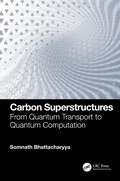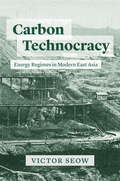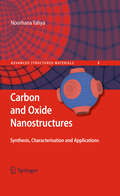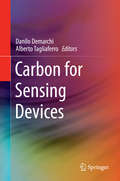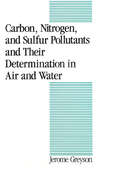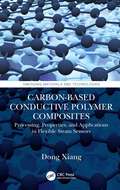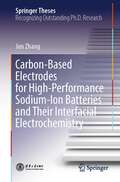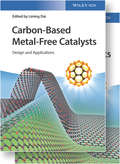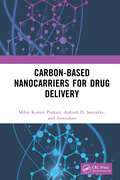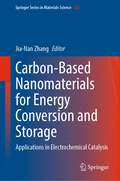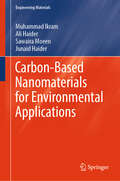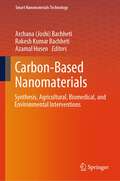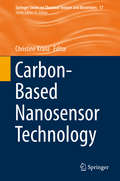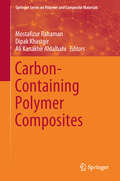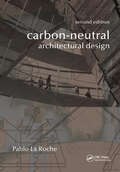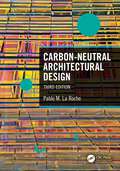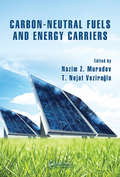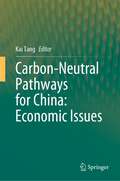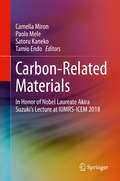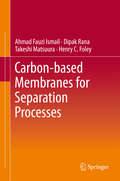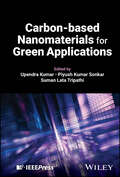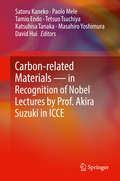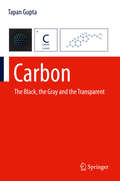- Table View
- List View
Carbon Superstructures: From Quantum Transport to Quantum Computation
by Somnath BhattacharyyaThis book covers how the understanding, as well as controllability, of the quantum electronic properties of carbon structures can be improved through a combined study of structural geometry, electronic properties, and dynamics of resonating valence bonds. It elaborates varied properties such as growth mechanism, exotic transport properties, namely unusual geometry of microstructures mixed with electron distribution and spin properties in carbon. Transport mechanisms and new applications including hybrid quantum technology based on the superconducting diamond and diamond nitrogen-vacancy (NV) centers are discussed.Features:• Includes the theoretical and experimental aspects of carbon physics, various carbon nanostructures, and simulations.• Covers growth of carbon superstructures and various applications of their tunable electronic properties.• Discusses how nanocarbon systems can be used in emerging technologies, including spintronic and quantum computing.• Focuses on spin-related features and spin transport including the Kondo effect, spin-charge separation, spin-phonon coupling, anomalous Hall effect, and Luttinger liquid features.• Explores carbon superstructure growth and their tunable electronic properties.This book is aimed at students, researchers in physics, chemistry, engineering, materials science, electronics, and quantum technology.
Carbon Technocracy: Energy Regimes in Modern East Asia (Studies of the Weatherhead East Asian Institute)
by Victor SeowA forceful reckoning with the relationship between energy and power through the history of what was once East Asia’s largest coal mine. The coal-mining town of Fushun in China’s Northeast is home to a monstrous open pit. First excavated in the early twentieth century, this pit grew like a widening maw over the ensuing decades, as various Chinese and Japanese states endeavored to unearth Fushun’s purportedly “inexhaustible” carbon resources. Today, the depleted mine that remains is a wondrous and terrifying monument to fantasies of a fossil-fueled future and the technologies mobilized in attempts to turn those developmentalist dreams into reality. In Carbon Technocracy, Victor Seow uses the remarkable story of the Fushun colliery to chart how the fossil fuel economy emerged in tandem with the rise of the modern technocratic state. Taking coal as an essential feedstock of national wealth and power, Chinese and Japanese bureaucrats, engineers, and industrialists deployed new technologies like open-pit mining and hydraulic stowage in pursuit of intensive energy extraction. But as much as these mine operators idealized the might of fossil fuel–driven machines, their extractive efforts nevertheless relied heavily on the human labor that those devices were expected to displace. Under the carbon energy regime, countless workers here and elsewhere would be subjected to invasive techniques of labor control, ever-escalating output targets, and the dangers of an increasingly exploited earth. Although Fushun is no longer the coal capital it once was, the pattern of aggressive fossil-fueled development that led to its ascent endures. As we confront a planetary crisis precipitated by our extravagant consumption of carbon, it holds urgent lessons. This is a groundbreaking exploration of how the mutual production of energy and power came to define industrial modernity and the wider world that carbon made.
Carbon Technocracy: Energy Regimes in Modern East Asia (Studies of the Weatherhead East Asian Institute)
by Victor SeowA forceful reckoning with the relationship between energy and power through the history of what was once East Asia’s largest coal mine. The coal-mining town of Fushun in China’s Northeast is home to a monstrous open pit. First excavated in the early twentieth century, this pit grew like a widening maw over the ensuing decades, as various Chinese and Japanese states endeavored to unearth Fushun’s purportedly “inexhaustible” carbon resources. Today, the depleted mine that remains is a wondrous and terrifying monument to fantasies of a fossil-fueled future and the technologies mobilized in attempts to turn those developmentalist dreams into reality. In Carbon Technocracy, Victor Seow uses the remarkable story of the Fushun colliery to chart how the fossil fuel economy emerged in tandem with the rise of the modern technocratic state. Taking coal as an essential feedstock of national wealth and power, Chinese and Japanese bureaucrats, engineers, and industrialists deployed new technologies like open-pit mining and hydraulic stowage in pursuit of intensive energy extraction. But as much as these mine operators idealized the might of fossil fuel–driven machines, their extractive efforts nevertheless relied heavily on the human labor that those devices were expected to displace. Under the carbon energy regime, countless workers here and elsewhere would be subjected to invasive techniques of labor control, ever-escalating output targets, and the dangers of an increasingly exploited earth. Although Fushun is no longer the coal capital it once was, the pattern of aggressive fossil-fueled development that led to its ascent endures. As we confront a planetary crisis precipitated by our extravagant consumption of carbon, it holds urgent lessons. This is a groundbreaking exploration of how the mutual production of energy and power came to define industrial modernity and the wider world that carbon made.
Carbon and Metal Oxides Based Nanomaterials for Flexible High Performance Asymmetric Supercapacitors (Springer Theses)
by Yating HuThis thesis examines electrode materials such as mesoporous carbons, manganese oxides, iron oxides and their nanohybrids with graphene. It also explores several of the key scientific issues that act as the governing principles for future development of supercapacitors, which are a promising class of high-efficiency energy storage devices for tackling a key aspect of the energy crisis. However, critical technical issues, such as the low energy density and reliability, need to be addressed before they can be extended to a wide range of applications with much improved performance. Currently available material candidates for the electrodes all have their disadvantages, such as a low specific capacitance or poor conductivity for transition metal oxide/hydroxide-based materials. This thesis addresses these important issues, and develops a high-performance, flexible asymmetric supercapacitor with manganese oxides/reduced graphene oxide as the positive electrode and iron oxide/reduced graphene oxide as the anode, which delivers a high energy density of 0.056 Wh cm-3.
Carbon and Oxide Nanostructures: Synthesis, Characterisation and Applications (Advanced Structured Materials #5)
by Noorhana YahyaThis volume covers all aspects of carbon and oxide based nanostructured materials. The topics include synthesis, characterization and application of carbon-based namely carbon nanotubes, carbon nanofibres, fullerenes, carbon filled composites etc. In addition, metal oxides namely, ZnO, TiO2, Fe2O3, ferrites, garnets etc., for various applications like sensors, solar cells, transformers, antennas, catalysts, batteries, lubricants, are presented. The book also includes the modeling of oxide and carbon based nanomaterials. The book covers the topics: Synthesis, characterization and application of carbon nanotubes, carbon nanofibres, fullerenes Synthesis, characterization and application of oxide based nanomaterials. Nanostructured magnetic and electric materials and their applications. Nanostructured materials for petro-chemical industry. Oxide and carbon based thin films for electronics and sustainable energy. Theory, calculations and modeling of nanostructured materials.
Carbon for Sensing Devices
by Danilo Demarchi Alberto TagliaferroThis book reveals why carbon is playing such an increasingly prominent role as a sensing material. The various steps that transform a raw material in a sensing device are thoroughly presented and critically discussed. The authors deal with all aspects of carbon-based sensors, starting from the various hybridization and allotropes of carbon, with specific focus on micro and nano sized carbons (e. g. , carbon nanotubes, graphene) and their growth processes. The discussion then moves to the role of functionalization and the different routes to achieve it. Finally, a number of sensing applications in various fields are presented, highlighting the connection with the basic properties of the various carbon allotropes. Readers will benefit from this book's bottom-up approach, which starts from the local bonding in carbon solids and ends with sensing applications, linking the local hybridization of carbon atoms and its modification by functionalization to specific device performance. This book is a must-have in the library of any scientist involved in carbon based sensing application.
Carbon, Nitrogen, and Sulfur Pollutants and Their Determination in Air and Water
by Jerome C. GreysonFor chemists and engineers in ecology, food science, pollution control, and related fields. Details the procedures available for monitoring and controlling carbon, sulfur, and nitrogen pollutants in such industries as waste water treatment, energy, transportation, pharmaceuticals, and mining. Outlin
Carbon-Based Conductive Polymer Composites: Processing, Properties, and Applications in Flexible Strain Sensors (Emerging Materials and Technologies)
by Dong XiangCarbon nanomaterials can transfer their excellent electrical conductivity to polymers while enhancing or maintaining their original mechanical properties. Conductive polymer composites based on carbon nanomaterials are finding increasing applications in aerospace, automotive, and electronic industries when flexibility or lightweight is required. Carbon-Based Conductive Polymer Composites: Processing, Properties, and Applications in Flexible Strain Sensors summarizes recent remarkable achievements in the processing–structure–property relationship of conductive polymer composites based on carbon nanomaterials. It also discusses research developments for their application in flexible strain sensors and novel processing methods like additive manufacturing. Presents the state of the art in conductive composite materials and their application in flexible strain sensors. Uniquely combines the processing, structure, properties, and applications of conductive polymer composites. Integrates theory and practice. Benefits plastics converters who wish to take full advantage of the potential of conductive plastic materials. This book is written for material scientists and engineers researching and applying these advanced materials for a variety of applications.
Carbon-Based Electrodes for High-Performance Sodium-Ion Batteries and Their Interfacial Electrochemistry (Springer Theses)
by Jun ZhangThis book focuses on the development of high-performance carbon electrodes for sodium ion batteries (SIBs). By proposing folded-graphene as the high-density cathode with excellent rate capability, it provides insight into the interplay between oxygen functional groups and folded texture. It also highlights the superiority of ether electrolytes matching with carbon anodes, which are shown to deliver largely improved electrochemical performance. The achievements presented offer a valuable contribution to the carbon-based electrodes in SIBs.
Carbon-Based Metal-Free Catalysts, 2 Volumes: Design and Applications
by Liming DaiOffering comprehensive coverage of this hot topic, this two-volume handbook and ready reference treats a wide range of important aspects, from synthesis and catalytic properties of carbon materials to their applications as metal-free catalysts in various important reactions and industrial processes. Following a look at recent advances in the development of carbon materials as carbon-based metal-free catalysts, subsequent sections deal with a mechanistic understanding for the molecular design of efficient carbon-based metal-free catalysts, with a special emphasis on heteroatom-doped carbon nanotubes, graphene, and graphite. Examples of important catalytic processes covered include clean energy conversion and storage, environmental protection, and synthetic chemistry. With contributions from world-leading scientists, this is an indispensable source of information for academic and industrial researchers in catalysis, green chemistry, electrochemistry, materials science, nanotechnology, energy technology, and chemical engineering, as well as graduates and scientists entering the field.
Carbon-Based Nanocarriers for Drug Delivery
by Mihir Kumar Purkait Ankush D. Sontakke AnweshanCarbon-Based Nanocarriers for Drug Delivery enlists the latitudes and advancements in the synthesis processes, functionalization, and applications of carbon-based nanomaterials (CBNs) in targeted drug delivery systems (DDSs). It covers the applicability and suitability of CBNs as nanocarriers for efficient drug delivery application via elucidating the recent advancements in CBNs, their functionalized and innovative derivatives, and the relevant case studies. The book explores the necessity, efficacy, toxicological aspects, and challenges for the application of CBN in targeted DDSs. Some of the features of this book are provided as follows: Provides elaborative description on significance and adaptability of carbon-based nanomaterial in targeted drug delivery for wide ranges of therapeutics Delivers a full-spectrum discussion on drug delivery through carbon-based nanocarriers Explores each carbon-based nanocarrier fundamentally for its drug and gene-delivery-related applications Describes critical discussion on various toxicological effects over the utilization of these nanocarriers Embraces existing as well as novel technologies/methodologies related to the synthesis and functionalization of CBNs, including graphene, graphene oxide, carbon quantum dots, carbon nanotube, fullerene, and smart carbon-based nanocarriers This book is aimed at researchers and graduate students in materials and pharmaceutical engineering, including drug delivery systems.
Carbon-Based Nanomaterials for Energy Conversion and Storage: Applications in Electrochemical Catalysis (Springer Series in Materials Science #325)
by Jia-Nan ZhangThis book systematically summarizes the advanced development of carbon-based nanomaterials for electrochemical catalysis, and it is comprised of four sections. The first section discusses about the fundamental synthesis, characterization techniques, and catalytic effects on the energy conversion and storage mechanism. The second section elaborately reviews various types of electrocatalytic reactions on carbon-based materials and their performance. The third section focuses on batteries about carbon-based materials with different storage mechanism. And the last one, the following enlightenment in terms of theoretical development and experimental research is provided to the general readers: 1) Precise design and construction of local atomic and electronic structures at the interface of catalysts; 2) Selective activation and directed conversion of carbon-based energy-carrying molecules at the interface; 3) Interaction mechanism and regulation of catalyst solid surface interface properties under environment and external field. This book will be useful for researchers and students who are interested in carbon-based nanomaterials, electrochemical catalysts and energy storage.
Carbon-Based Nanomaterials for Environmental Applications (Engineering Materials)
by Muhammad Ikram Ali Haider Sawaira Moeen Junaid HaiderThis book delves into the incredible potential of carbon-based nanomaterials to solve critical ecological problems. Over the last few decades, substantial research has been conducted on the design and development of advanced nanomaterials for efficient energy storage, wastewater treatment, and antibacterial activities. Carbon-based materials have drawn increasing attention owing to their intriguing physicochemical properties and broad range of promising applications. Learn how these innovative materials are transforming our planet for improvements in areas as diverse as pollution management, purging water, and renewable energy. In this book, the authors briefly introduce the classification of carbon-based materials followed by describing in detail the various synthetic methods classified in two categories, i.e., bottom-up methods and top-down methods. After introducing the synthesis, environmental applications including water purification, air purification, and energy storage and antibacterial activity are explained. Finally, the challenges and opportunities in this promising research area are also proposed. In the current book, carbon-based nanomaterials are addressed in aim for sufficient energy production, wastewater treatment, and as an antibacterial agent. In Chapters 1 and 2, the authors overview the introduction and classifications of carbon-based nanomaterials with its fabrication process. In the next section, the authors review the water purification applications and improvement in the dye degradation activity of carbon-based materials including doping, increasing surface area, and many others. Chapter 4 covers the air purification and energy applications of carbon-based materials along with their experimental and theoretical studies. Moreover, the next chapter explores carbon-based materials for antibacterial activity. This book is specially designed for research purposes and helps the beginners, post-graduate students, and experienced researchers who are working on carbon-based materials and their applications. The book sheds critical light on the ways in which these materials might help make the world a better, more sustainable place.
Carbon-Based Nanomaterials: Synthesis, Agricultural, Biomedical, and Environmental Interventions (Smart Nanomaterials Technology)
by Azamal Husen Rakesh Kumar Bachheti Archana Joshi BachhetiCarbon nanomaterials have several applications, which is driving up scientific research into them. The book showcases the most recent advancements and research discoveries rather than just providing an overview. Each chapter offers authoritative insights into the ever-changing field of carbon-based nanomaterials, as written by top authorities in their respective domains. The book stands out for its persistent focus on real-world application. It is devoted to practical applications and is divided into four sections. The intriguing promise of carbon nanomaterials, their synthesis, and their possible uses set the stage for the adventure. Subsequently, the emphasis shifts to agriculture, where nanomaterials have been shown to improve plant health, fend against illnesses, promote growth and development, and even help detect and remove herbicides. The biomedical part explores the potential toxicological ramifications of these materials while introducing the reader to their ground-breaking role in drug delivery, tissue engineering, and the fight against fungal diseases. Overall, the book provides valuable insights and serves as a comprehensive resource for researchers and scientists across various interdisciplinary subjects.
Carbon-Based Nanosensor Technology (Springer Series on Chemical Sensors and Biosensors #17)
by Christine KranzCarbon nanomaterials have gained relevance in chem/bio sensing applications owing to their unique chemical, mechanical, electrical, and thermal characteristics. Written by leading experts in the field, this book discusses selected, state-of-the art carbon-based nanomaterials, including nanodiamonds, graphene nanodots, carbon nanopores, and nanocellulose. It presents examples of chem/bio sensing applications ranging from biomedical studies, such as DNA sequencing and neurotransmitter sensing, to heavy-metal detection in environmental monitoring scenarios, and reviews the unique properties of carbon-based nanomaterials with respect to targeted sensing applications. Further, it highlights exciting future applications. Providing comprehensive information for practitioners and scientists working in the field of carbon nanomaterial technologies and their application, it is also a valuable resource for advanced students of analytical chemistry, biochemistry, electrochemistry, materials science, and micro-/nanotechnology and -sensing.
Carbon-Containing Polymer Composites (Springer Series on Polymer and Composite Materials)
by Mostafizur Rahaman Dipak Khastgir Ali Kanakhir AldalbahiThis book discusses the methods synthesizing various carbon materials, like graphite, carbon blacks, carbon fibers, carbon nanotubes, and graphene. It also details different functionalization and modification processes used to improve the properties of these materials and composites. From a geometrical–structural point of view, it examines different properties of the composites, such as mechanical, electrical, dielectric, thermal, rheological, morphological, spectroscopic, electronic, optical, and toxic, and describes the effects of carbon types and their geometrical structure on the properties and applications of composites.
Carbon-Neutral Architectural Design
by Pablo M. La RocheThe energy used to operate buildings is one of the most significant sources of greenhouse gas emissions. While it is possible to reduce emissions through climate-responsive design, many architects are not trained to do this. Filling an urgent need for a design reference in this emerging field, this book describes how to reduce building-related greenhouse gas emissions through appropriate design techniques. It presents strategies to achieve CO2 reductions, with an emphasis on control of energy flows through the building envelope and passive heating and cooling strategies. This new, revised edition is updated throughout, and includes a new chapter on building simulations.
Carbon-Neutral Architectural Design
by Pablo M. La RocheThe energy used to build and operate buildings is a significant source of greenhouse gas emissions. While it is possible to reduce emissions through low-carbon design, many architects are not trained to do this. Filling an urgent need for a design reference in this emerging field, this book describes how to reduce building-related greenhouse gas emissions through appropriate design techniques. It presents strategies to achieve CO2 reductions, with an emphasis on control of energy flows through the building envelope and passive cooling and heating strategies. This new, revised edition is updated throughout and includes a new section on embodied carbon and new chapters on daylighting and nature-based cooling.Features: Adds new chapters on daylighting and nature-based cooling with numerous updates throughout the rest of the chapters Presents strategies, illustrated with examples, for new construction and existing buildings to reduce energy consumption and reduce emissions Explains the origins of CO2 emissions associated with the operation and fabrication of buildings: supplying water, disposing of waste from the building, and proposes strategies to reduce them Covers carbon calculations, thermal comfort, indigenous technology, climate‑responsive design, passive cooling and heating, solar design, air flow analysis, daylighting, building simulation and microclimate design with abundant examples Examines siting/location to design buildings that adapt and mitigate their effect on climate change
Carbon-Neutral Fuels and Energy Carriers (Green Chemistry and Chemical Engineering)
by Nazim Z. Muradov T. Nejat VeziroǧluConcerns over an unstable energy supply and the adverse environmental impact of carbonaceous fuels have triggered considerable efforts worldwide to find carbon-free or low-carbon alternatives to conventional fossil fuels. Carbon-Neutral Fuels and Energy Carriers emphasizes the vital role of carbon-neutral energy sources, transportation fuels, and a
Carbon-Neutral Pathways for China: Economic Issues
by Kai TangThis book provides comprehensive economic analyses on the paths to net-zero for China. It gives a detailed overview of issues and challenges related to carbon neutrality of the global largest emitter which have not been adequately addressed e.g., reduction costs and efficiency of existing actions, the multiple impacts of the newly established carbon market, and the potentials and costs of nature-based solutions such as biophysical sequestration, etc. Studies on China’s carbon reduction have attracted scientists and policymakers from diverse backgrounds. Pursuing a holistic and systematic approach, the book establishes a fundamental framework for this topic, emphasizing the importance of integrated technical-economic-policy analysis. This book will not only be an essential reference to the carbon-neutral progress in China but also will be an outstanding text book on carbon-neutral management. Similarly, this book is expected to attract a great range of readership including undergraduate and postgraduate students, economic and climate specialists, researchers and policymakers in China as well as in overseas.
Carbon-Related Materials: In Honor of Nobel Laureate Akira Suzuki’s Lecture at IUMRS-ICEM 2018
by Paolo Mele Tamio Endo Satoru Kaneko Camelia MironThis book will give a detailed description of different carbon based materials synthesis methods, characterization, and applications. It serves as a fundamental information source on the actual techniques and methodologies involved in carbon materials synthesis, such as CVD, plasma in liquids, fusion reactors, or frequency-doubled yttrium–aluminum– garnet (YAG) lasers. This book includes coverage of several categories of carbon materials, such as graphene, carbon fiber composites, functionalized carbons, and polyimides used for various applications, from microelectronic industry to slotted waveguide antennas.
Carbon-based Membranes for Separation Processes
by Takeshi Matsuura Dipak Rana Ahmad Fauzi Ismail Henry C. FoleyThis book provides a significant overview of carbon-related membranes. It will cover the development of carbon related membranes and membrane modules from its onset to the latest research on carbon mixed matrix membranes. After reviewing progress in the field, the authors indicate future research directions and prospective development. The authors also attempt to provide a guideline for the readers who would like to establish their own laboratories for carbon membrane research. For this purpose, detailed information on preparation, characterization and testing of various types of carbon membrane is provided. Design and construction of carbon membrane modules are also described in detail.
Carbon-based Nanomaterials for Green Applications
by Upendra Kumar Suman Lata Tripathi Piyush Kumar SonkarGain valuable insight into applying carbon-based nanomaterials to the green technologies of the future The green revolution is the most important technological development of the new century. Carbon-based nanomaterials, with their organic origins and immense range of applications, are increasingly central to this revolution as it unfolds. There is an urgent need for an up-to-date overview of the latest research in this ever-expanding field. Carbon-Based Nanomaterials for Green Applications meets this need by providing a brief outline of the synthesis and characterization of different carbon-based nanomaterials, including their historical backgrounds. It proceeds to move through each major category, outlining properties and applications for each. The result is an essential contribution to a huge range of sustainable and renewable industries. With contributions from a global list of distinguished writers, the book includes: Discussion of nanomaterial applications in fields from drug delivery to biomedical technology to optics Analysis of nanomaterial categories including graphene, fullerene, mesoporous carbon, and many more Separate chapters describing aspects of supercapacitors, solar cells, and fuel cells Carbon-Based Nanomaterials for Green Applications is ideal for scientists and researchers working in nanotechnology, life sciences, biomedical research, bioengineering, and a range of related fields.
Carbon-related Materials in Recognition of Nobel Lectures by Prof. Akira Suzuki in ICCE
by David Hui Paolo Mele Tamio Endo Tetsuo Tsuchiya Satoru Kaneko Katsuhisa Tanaka Masahiro YoshimuraThis book summarizes the recent advances in carbon related materials. It covers both experimental and theoretical approaches in several categories, including such carbon nanomaterial as polymers, carbon nanocomposites, and graphene. It also discusses device applications, as carbon-based materials that have recently received much attention due to their various potential applications. The editors dedicate this book to Nobel Laureate Akira Suzuki for his 85th birthday.
Carbon: The Black, the Gray and the Transparent
by Tapan GuptaAll living things contain carbon in some form, as it is the primary component of macromolecules including proteins, lipids, nucleic acids (RNA and DNA), and carbohydrates. As a matter of fact, it is the backbone of all organic (chemistry) compounds forming different kinds of bonds. Carbon: The Black, the Gray and the Transparent is not a complete scientific history of the material, but a book that describes key discoveries about this old faithful element while encouraging broader perspectives and approaches to its research due to its vast applications. All allotropes of carbon are described in this book, along with their properties, uses, and methods of procurement or manufacturing. Black carbon is represented by coal, gray carbon is represented by graphite, and transparent carbon is represented by diamond.
